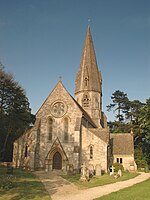Ascott-under-Wychwood railway station
DfT Category F2 stationsFormer Great Western Railway stationsRailway stations in Great Britain opened in 1853Railway stations in OxfordshireRailway stations served by Great Western Railway ... and 2 more
South East England railway station stubsUse British English from August 2017

Ascott-under-Wychwood railway station is a railway station serving the village of Ascott-under-Wychwood in Oxfordshire, England. It is on the Cotswold Line. The station, and all trains serving it, are operated by Great Western Railway. West of the station is a level crossing, controlled by Ascott-under-Wychwood Signal Box, which also oversees the adjacent end of the double-tracked section of the Cotswold Line. Under proposals to extend the doubling of the route, the signal box was to be removed but budgetary constraints on resignalling led to that proposal being revised.
Excerpt from the Wikipedia article Ascott-under-Wychwood railway station (License: CC BY-SA 3.0, Authors, Images).Ascott-under-Wychwood railway station
West Oxfordshire Ascott-under-Wychwood
Geographical coordinates (GPS) Address Nearby Places Show on map
Geographical coordinates (GPS)
| Latitude | Longitude |
|---|---|
| N 51.867 ° | E -1.564 ° |
Address
OX7 6AJ West Oxfordshire, Ascott-under-Wychwood
England, United Kingdom
Open on Google Maps









